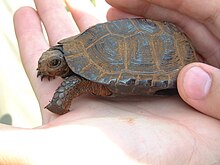Glyptemys
|
Glyptemys Temporal range: 0–0 Ma Neogene() - Recent |
|
|---|---|
 |
|
| Glyptemys muhlenbergii | |
| Scientific classification | |
| Kingdom: | Animalia |
| Phylum: | Chordata |
| Class: | Reptilia |
| Order: | Testudines |
| Family: | Emydidae |
| Subfamily: | Emydinae |
| Genus: |
Glyptemys Agassiz, 1857 |
| Species | |
Glyptemys is a genus of turtles in the family Emydidae. It comprises two species, the bog turtle and wood turtle, both of which are endemic to North America. Until 2001, these turtles were considered members of the genus Clemmys, which currently has one member, the spotted turtle.
Full grown, these turtles grow to between 8.9 and 20 cm (3.5 and 7.9 in). These turtles are semiaquatic, although this varies based on season. Their morphological characteristics make them unique from other species and unique from each other.
Glyptemys turtles prefer slow moving streams and ponds, and feed on insects, plant matter, small invertebrates, and carrion. These turtles are protected throughout their range.
The taxonomic classification of Emydidae turtles has been eventful and many schools of thought are given about how the different genera and species should be arranged.
Before 2001, the bog and wood turtles were members of the Clemmys genus, but they were moved to a newly created genus, Glyptemys, after further morphological and genetic analyses revealed they were much closer relatives to each other than to the spotted turtle. The bog turtle and wood turtle have similar genetic makeups that are marginally different from that of the spotted turtle, the only current member of the Clemmys genus. The western pond turtle was also a former member of Clemmys, but it was recently moved to the genus Actinemys, of which it is now the only member. Both Glyptemys turtles have karyotypes of 50 chromosomes.
...
Wikipedia
